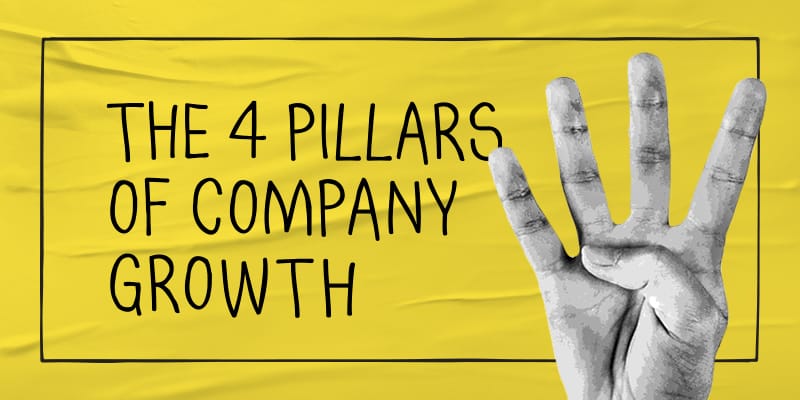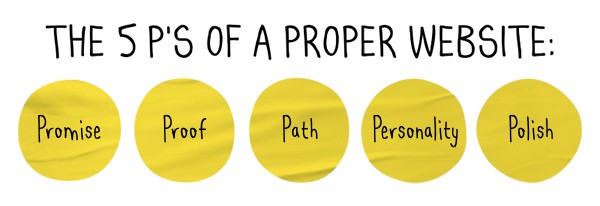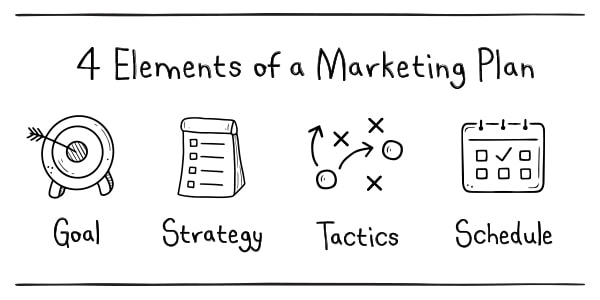
Why did you start a company? There are easier ways to make a buck. The entrepreneurial life is not one to enter half-assed. You either come in with your whole ass or not at all.
It’s painful watching so many companies struggle. Especially when it doesn’t have to be so hard. Nobody has a magic system that makes entrepreneurship easy, but it can be easier if you pay attention to the right things.
The four pillars of growth are those things. I’ve polished these concepts over 17 years of working with hundreds of companies. This article walks you through how to leverage your product, brand, website, and marketing to drive sustainable growth. It isn’t sexy or revolutionary, but it’s proven and practical.
The reality is that you don’t need all four pillars to see short-term success. A unique product or crazy marketing stunt can put you on the map, but sustained growth for years requires all four pillars. If you’re working to build a company that lasts decades, this article is for you.
Growth Pillar 1: Product
Your product should sell itself after the first purchase. If that isn’t happening, you need to fix your product before you worry about marketing. You can’t build a business on one-time customers. It’s like running on a treadmill. No matter how hard you work, you won’t go anywhere.
One-time purchases and a lack of referrals are a flashing warning sign that you’ve got a product problem. People don’t have to be incentivized to tell their friends if your product is killer. We’ll sing your praises to everyone we know to make ourselves look good if we know about an awesome product. We want to be the person in the know.
We also don’t have to be told to buy something again if the product is fantastic. Repeat purchases happen naturally when a product delivers on a promise. If referrals and repeat purchases aren’t happening, focus on making your product better because no company can grow without a solid product.
The key is to give disproportionate time to finding the one spot where you’re going to hang your hat as a company. Your product can be serviceable everywhere else if you’re truly remarkable in one spot. You just have to find the one spot that matters to the people you want as customers.
Growth Pillar 2: Brand
Your brand is not your logo. The word brand is synonymous with reputation. As Jeff Bezos once said, your brand is what people say about you when you’re not in the room. Branding is everything you do to shape that reputation. Think of your logo like the face of your brand. It’s how people associate the reputation with the entity. And yes, a pretty face and polished appearance is an asset in many circumstances, but a pretty face alone won’t build a brand.
The true benefit of branding is that customers will choose you regardless of price or convenience if you do it right. Weed through your life and I guarantee you’ll find countless examples where you ignore price and convenience thanks to brand loyalty.
I’ll drive past four cheaper BBQ restaurants to go to my favorite.
I make special trips to Whole Foods to pick up my special yogurt even though I do all of my shopping at another grocery store.
I spend thousands of dollars on Apple products when I can get a fairly equivalent phone and computer for half the price.
Brands are powerful. It takes time, effort, and consistency to build one, but it can pay off for decades once you do. Your job is to determine the brand you want and then cast consistent votes to make that reputation (brand) a reality.
This is a deep subject with lots to cover. I can’t walk through the full process of building a brand in this article so I’ll share some links to send you in the right direction. Here are a few helpful branding articles to get you started:
- How To Create A Brand Positioning Strategy
- What A Brand Promise Is and How To Write One
- How To Craft A Brand Script That Sells Like Ice Cream In The Desert
- 3 Steps To A Ridiculously Persuasive Brand Story
- What Brand Personality Is and How To Use It To Break Into A Competitive Market
Growth Pillar 3: Website
Your website is the hub of your business. I don’t care what you sell, your website is often where the buying process takes place. It’s amazing how many businesses waste this prime real estate and crap on their own efforts with a weak website.
And I’m going to let you in on a little secret, nailing your website isn’t complicated. As much as the brand story gurus want you to believe it’s a convoluted puzzle only they can crack, it’s not. All you have to do is follow the five Ps of a proper website.

Promise
Make a big promise front and center above the fold. Tell the people you want to buy what’s in it for them. Don’t waste that prime real estate with your logo, talking about yourself, or anything other than a message that tells the buyer you want what fantastic result they’re going to get if they give you money.
Proof
Show proof you’ve delivered for people just like them right below your big promise. Testimonials, reviews, customer or client logos, and case studies are all great examples of proof you can use to put a visitor’s worries at ease. Show them they’re not the first person to buy and make them feel good about giving you money.
Path
Don’t make it hard for people to buy from you. Decide the most valuable action for someone to take on each page of your website and make that action clear. Provide a manicured path that leads them right to handing you money. Don’t throw a bunch of options, detours, and alternate routes in their way confusing things (aka three buttons at every turn). If you don’t know what you want people visiting your website to do, they sure as hell won’t know what to do.
Personality
Most websites read like jargon-filled crap. Write your website like you talk. Make it casual, approachable, and enjoyable. This holds true even if you sell technical products or services to an educated audience. Nobody wants to stick around on a website that reads like a product manual. Injecting a little personality is an easy way to separate from 90% of your competitors and make a personal connection with visitors.
Polish
Serve all of the above up with a little polish. Your website is often the first impression and the point of conversion for customers. A polished design can be the difference between a new customer and a quick bounce. Take advantage of the platforms, templates, and professionals that make it easy to have a beautiful and powerful website.
Growth Pillar 4: Marketing
Many of the folks who walk through our door jump straight to marketing. Everyone thinks bad marketing is why they aren’t growing, but it’s often a product, brand, or website problem. We have to correct these foundational items before marketing will work. You need to do the same. Make sure your product, brand, and website are ready before you start spending time and money on marketing.
Assuming you’ve got everything dialed and ready, let’s get into marketing. It’s easy to make marketing hard. The best results usually come from the simplest plans. I’ve seen really simple plans that are mediocre at best outperform brilliant plans that are too complex to execute repeatedly. You don’t need a 15-page document with executive summaries and sophisticated projections. You just need four things:

Goal
Marketing exists to move you toward a business goal, so a business goal should be at the top of your marketing plan. Here’s an easy framework we use for every client to help them think about their goals…
“Pretend it’s two years from today, paint a picture of the company you want to exist. What are your total sales? How do they break down between products? What are you known for as a company?”
Two years is far enough out that it removes you from the fires of today, but it’s not so far that it feels ridiculous to consider. Answer the question in detail and then lay in monthly milestones you can check to see if you’re tracking toward your goal. If you miss your milestone four months in a row, it’s time to evaluate what you’re doing and why you’re missing your goal. Most companies neglect this step and that’s why their marketing (and business) strategy feels like a blind man with earmuffs shooting at enemy targets.
Strategy
Strategy is how you’re going to achieve the goal you set. Let’s say we’re a brewery and our goal is to sell 50,000 beers on premise per month to hit our goal of 1,200,000 beers sold in two years. We simply ask ourselves,
“How are we going to sell 50,000 beers per month?”
The answer to this question is our marketing strategy. This is often tied back to the product and brand strategy as well. For our brewery example, our strategy would be to become the option for IPA lovers. We’d carry more IPAs on tap, house IPA tasting events, show IPA videos online, carry IPA merch, feature a weekly IPA lover email, etc…
We’d be serviceable with our other types of beer, but we’d be the best at IPAs. Our brewery would be the destination for IPA lovers. That’s how you sling 50,000 beers per month and stand out from the throngs of breweries everywhere. Becoming the option for IPA lovers is a marketing strategy we can put tactics to and make happen.
Tactics
Your strategy is the big picture of how you’re going to get customers. Tactics are the specifics of how you’re actually going to make it happen. There are three phases of tactics you need to plan for in marketing.
Phase 1 Tactics: Attract – People can’t buy from you if they don’t know you exist. In this phase, you need to use awareness assets with big audiences. For most businesses this will be social media sites or search engines. Figure out the one where your customers are and focus your efforts on being fantastic in that spot. Your goal is to make them aware you exist and get them into your ecosystem where you can engage them.
Phase 2 Tactics: Engage – Most customers need a couple dates before they buy. They visit your social profile and website a few times and if you do a good enough job they’ll make a purchase. Engagement initiatives are your opportunity to build a relationship and earn their trust. Email marketing is still king here, but it’s not the only option. The key is to build an engagement channel where you take people from your awareness asset to engagement so you can convert them into a customer.
Phase 3 Tactics: Delight – This is the most neglected tactical phase. You can’t stop marketing to your customers. Delighting current customers will always be the best marketing a company can leverage. Make sure you document how you’re going to delight customers before, during, and after their purchase.
Schedule
The last piece of the puzzle is the most often overlooked. A crappy marketing plan executed rigorously will outperform a brilliant plan with weak execution. Setting a schedule and assigning responsibilities is the simple solution that ensures execution. It’s hard for people to drop the ball when you have a clear schedule holding them accountable. Even if you’re a one person team, build a schedule and hold yourself accountable. A huge portion of marketing success is showing up consistently.
Ignore The Outliers
I told you at the beginning that the four pillars aren’t sexy or revolutionary, but they are the ingredients for sustainable growth. I’m sure there are outliers that succeed with an awful website or terrible marketing. You’ll find exceptions to every rule. Throw out the outliers. Pay attention to what consistently works.
Obsess on your product and get it right before you worry about anything else. Determine who you want to be as a brand and cast consistent votes to make it a reality. Follow the 5 Ps of a proper website and maximize the value of your digital real estate. And finally, execute a simple marketing plan that moves you toward a business goal by attracting, engaging, and delighting a specific group of people.
Working to build a brand? I can help. Join several thousand entrepreneurs getting The Recipe and I’ll send you my best branding and marketing tips every Friday.
